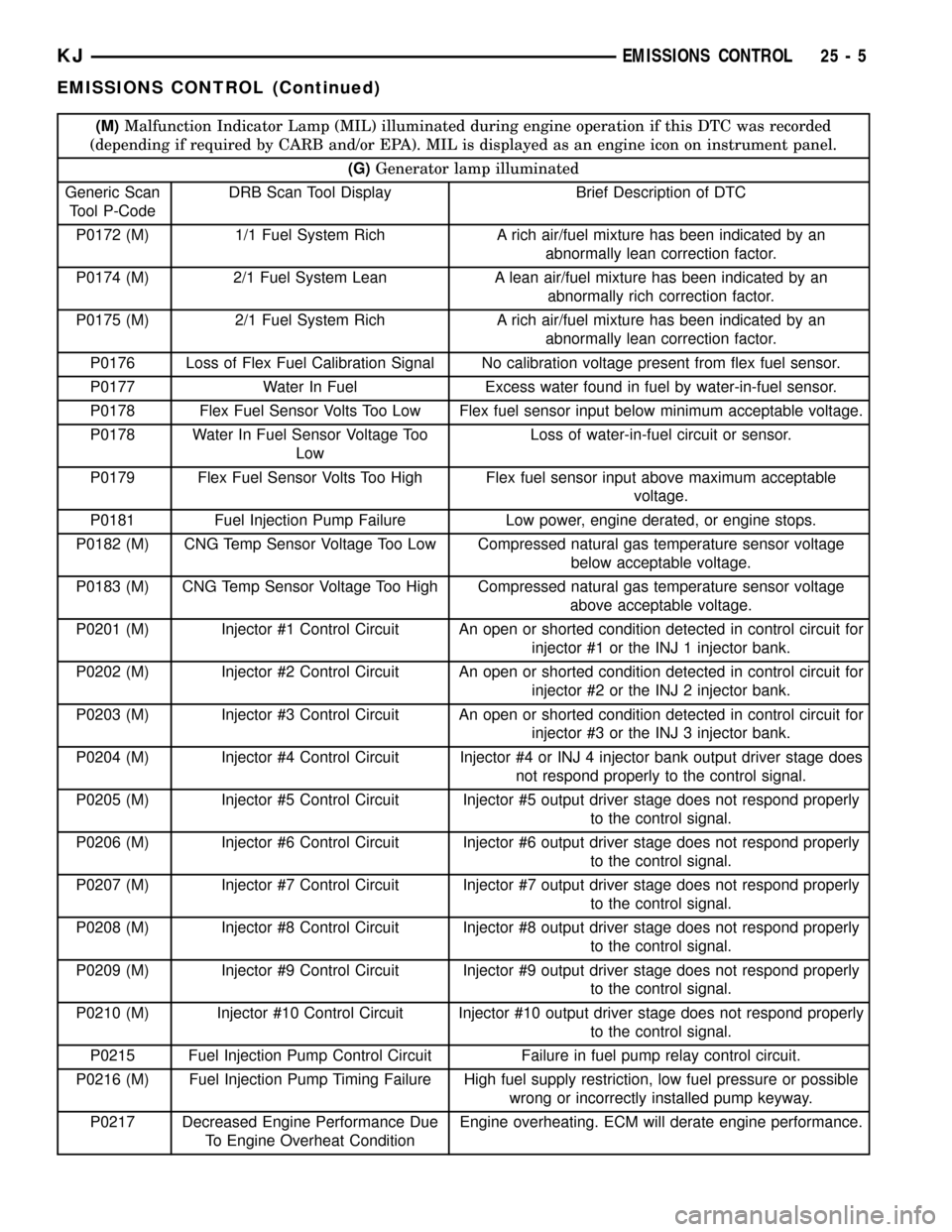2002 JEEP LIBERTY Heating system
[x] Cancel search: Heating systemPage 1702 of 1803

(1) Install the evaporator coil unit into of the lower
half of the HVAC housing. Be certain that the evap-
orator foam insulator wrap and rubber tube seal are
reinstalled.
(2) Reassemble and install the HVAC housing.
(Refer to 24 - HEATING & AIR CONDITIONING/
DISTRIBUTION/HVAC HOUSING - ASSEMBLY)
(Refer to 24 - HEATING & AIR CONDITIONING/
DISTRIBUTION/HVAC HOUSING - INSTALLA-
TION)
NOTE: If the evaporator was replaced, add 60 milli-
liters (2 fluid ounces) of refrigerant oil to the refrig-
erant system. Use only refrigerant oil of the type
recommended for the compressor in the vehicle.
(Refer to 24 - HEATING & AIR CONDITIONING/
PLUMBING/REFRIGERANT OIL - DESCRIPTION)
A/C ORIFICE TUBE
DESCRIPTION
The fixed orifice tube is installed in the liquid line
(left-hand drive) or liquid line jumper (right-hand
drive) between the outlet of the condenser and the
inlet of the evaporator. The fixed orifice tube islocated in the end of the liquid line or liquid line
jumper that is closest to the condenser outlet tube.
The inlet end of the fixed orifice tube has a nylon
mesh filter screen, which filters the refrigerant and
helps to reduce the potential for blockage of the
metering orifice by refrigerant system contaminants
(Fig. 11). The outlet end of the tube has a nylon
mesh diffuser screen. The O-rings on the plastic body
of the fixed orifice tube seal the tube to the inside of
the liquid line and prevent the refrigerant from
bypassing the fixed metering orifice.
OPERATION
The fixed orifice tube is used to meter the flow of
liquid refrigerant into the evaporator coil. The high-
pressure liquid refrigerant from the condenser
expands into a low-pressure liquid as it passes
through the metering orifice and diffuser screen of
the fixed orifice tube.
The fixed orifice tube cannot be repaired and, if
faulty or plugged, the liquid line and fixed orifice
tube unit or liquid line jumper and fixed orifice tube
unit must be replaced.
REMOVAL
The fixed orifice tube is located in the liquid line
(Left-Hand Drive) or the liquid line jumper (Right-
Hand Drive) near the condenser. The orifice has filter
screens on the inlet and outlet ends of the tube body.
If the fixed orifice tube is faulty or plugged, the liq-
uid line unit or liquid line jumper unit must be
replaced. (Refer to 24 - HEATING & AIR CONDI-
TIONING/PLUMBING/LIQUID LINE - REMOVAL)
INSTALLATION
The fixed orifice tube is located in the liquid line
(Left-Hand Drive) or the liquid line jumper (Right-
Hand Drive) near the condenser. The orifice has filter
screens on the inlet and outlet ends of the tube body.
If the fixed orifice tube is faulty or plugged, the liq-
uid line unit or liquid line jumper unit must be
Fig. 10 Blend Door
1 - DEFROSTER DOOR
2- HEATER CORE
3- BLEND DOORS
4- BLOWER MOTOR HOUSING
5- EVAPORATOR (A/C ONLY)
6- LOWER HVAC CASE ASSEMBLY
Fig. 11 FIXED ORIFICE TUBE - TYPICAL
1 - DIFFUSER SCREEN
2-9O9RINGS
3 - INLET FILTER SCREENS
4 - ORIFICE
24 - 50 PLUMBINGKJ
A/C EVAPORATOR (Continued)
Page 1703 of 1803

replaced. (Refer to 24 - HEATING & AIR CONDI-
TIONING/PLUMBING/LIQUID LINE - REMOVAL)
ACCUMULATOR
DESCRIPTION
The accumulator is mounted in the engine com-
partment between the evaporator coil outlet tube and
the compressor inlet.
OPERATION
Refrigerant enters the accumulator canister as a
low pressure vapor through the inlet tube. Any liq-
uid, oil-laden refrigerant falls to the bottom of the
canister, which acts as a separator. A desiccant bag is
mounted inside the accumulator canister to absorb
any moisture which may have entered and become
trapped within the refrigerant system (Fig. 12).
REMOVAL
WARNING: REVIEW THE WARNINGS AND CAU-
TIONS IN THE FRONT OF THIS SECTION BEFORE
PERFORMING THE FOLLOWING OPERATION.
(Refer to 24 - HEATING & AIR CONDITIONING/
PLUMBING - WARNING) (Refer to 24 - HEATING &
AIR CONDITIONING/PLUMBING - CAUTION)
(1) Disconnect and isolate the battery negative
cable.
(2) Recover the refrigerant from the refrigerant
system. (Refer to 24 - HEATING & AIR CONDI-
TIONING/PLUMBING - STANDARD PROCEDURE -
REFRIGERANT RECOVERY)
(3) Unplug the wire harness connector from the
low pressure cycling clutch switch.
(4) Loosen the screw that secures the accumulator
retaining band to the support bracket on the dash
panel (Fig. 13).
(5) Disconnect the suction line from the accumula-
tor outlet tube refrigerant line fitting. (Refer to 24 -
HEATING & AIR CONDITIONING/PLUMBING -
STANDARD PROCEDURE - A/C LINE COUPLERS)
Install plugs in, or tape over all of the opened refrig-
erant line fittings.
(6) Disconnect the accumulator inlet tube refriger-
ant line fitting from the evaporator outlet tube.
(Refer to 24 - HEATING & AIR CONDITIONING/
PLUMBING - STANDARD PROCEDURE - A/C LINE
COUPLERS) Install plugs in, or tape over all of the
opened refrigerant line fittings.
(7) Pull the accumulator and retaining band unit
forward until the screw in the band is clear of the
slotted hole in the support bracket on the dash panel.
(8) Remove the accumulator from the vehicle.
INSTALLATION
WARNING: REVIEW THE WARNINGS AND CAU-
TIONS IN THE FRONT OF THIS SECTION BEFORE
PERFORMING THE FOLLOWING OPERATION.
(Refer to 24 - HEATING & AIR CONDITIONING/
PLUMBING - WARNING) (Refer to 24 - HEATING &
AIR CONDITIONING/PLUMBING - CAUTION) (Refer
to 24 - HEATING & AIR CONDITIONING/PLUMBING -
CAUTION - REFRIGERANT HOSES/LINES/TUBES
PRECAUTIONS)
(1) Install the accumulator and retaining band as
a unit by sliding the screw in the band into the slot-
ted hole in the support bracket on the dash panel.
(2) Remove the tape or plugs from the refrigerant
line fittings on the accumulator inlet tube and the
Fig. 12 ACCUMULATOR - TYPICAL
1 - A/C LOW PRESSURE SWITCH
2 - PRESSURE SWITCH FITTING
3 - OUTLET TO COMPRESSOR
4 - ANTI-SIPHON HOLE
5 - DESICCANT BAG
6 - OIL RETURN ORIFICE FILTER
7 - VAPOR RETURN TUBE
8 - ACCUMULATOR DOME
9 - O-RING SEAL
10 - INLET FROM EVAPORATOR
KJPLUMBING 24 - 51
A/C ORIFICE TUBE (Continued)
Page 1704 of 1803

evaporator outlet tube. Connect the accumulator inlet
tube refrigerant line coupler to the evaporator outlet
tube. (Refer to 24 - HEATING & AIR CONDITION-
ING/PLUMBING - STANDARD PROCEDURE - A/C
LINE COUPLERS)
(3) Tighten the accumulator retaining band screw
to 5 N´m (45 in. lbs.).
(4) Remove the tape or plugs from the refrigerant
line fittings on the suction line and the accumulator
outlet tube. Connect the suction line to the accumu-
lator outlet tube refrigerant line coupler. (Refer to 24
- HEATING & AIR CONDITIONING/PLUMBING -
STANDARD PROCEDURE - A/C LINE COUPLERS)
(5) Plug the wire harness connector into the low
pressure cycling clutch switch.
(6) Connect the battery negative cable.
(7) Evacuate the refrigerant system. (Refer to 24 -
HEATING & AIR CONDITIONING/PLUMBING -
STANDARD PROCEDURE - REFRIGERANT SYS-
TEM EVACUATE)
(8) Charge the refrigerant system. (Refer to 24 -
HEATING & AIR CONDITIONING/PLUMBING -
STANDARD PROCEDURE - REFRIGERANT SYS-
TEM CHARGE)NOTE: If the accumulator is replaced, add 120 mil-
liliters (4 fluid ounces) of refrigerant oil to the
refrigerant system. Use only refrigerant oil of the
type recommended for the compressor in the vehi-
cle. (Refer to 24 - HEATING & AIR CONDITIONING/
PLUMBING/REFRIGERANT OIL - DESCRIPTION)
HEATER CORE
DESCRIPTION
The heater core is located in the HVAC housing,
under the instrument panel. It is a heat exchanger
made of rows of tubes and fins and uses warm engine
coolant as its heat source.
OPERATION
Engine coolant is circulated through heater hoses
to the heater core at all times. As the coolant flows
through the heater core, heat removed from the
engine is transferred to the heater core fins and
tubes. Air directed through the heater core picks up
the heat from the heater core fins. The temperature
control door allows control of the heater output air
temperature by controlling how much of the air flow-
ing through the HVAC housing is directed through
the heater core. The blower motor speed controls the
volume of air flowing through the HVAC housing.
The heater core cannot be repaired and, if faulty or
damaged, it must be replaced. Refer to Cooling for
more information on the engine cooling system, the
engine coolant and the heater hoses.
REMOVAL
WARNING: ON VEHICLES EQUIPPED WITH AIR-
BAGS, DISABLE THE AIRBAG SYSTEM BEFORE
ATTEMPTING ANY STEERING WHEEL, STEERING
COLUMN, OR INSTRUMENT PANEL COMPONENT
DIAGNOSIS OR SERVICE. DISCONNECT AND ISO-
LATE THE BATTERY NEGATIVE (GROUND) CABLE,
THEN WAIT TWO MINUTES FOR THE AIRBAG SYS-
TEM CAPACITOR TO DISCHARGE BEFORE PER-
FORMING FURTHER DIAGNOSIS OR SERVICE. THIS
IS THE ONLY SURE WAY TO DISABLE THE AIRBAG
SYSTEM. FAILURE TO TAKE THE PROPER PRE-
CAUTIONS COULD RESULT IN AN ACCIDENTAL
AIRBAG DEPLOYMENT AND POSSIBLE PERSONAL
INJURY.
Fig. 13 A/C LOW PRESSURE SWITCH
1 - WIRING HARNESS CONNECTOR
2 - A/C LOW PRESSURE SWITCH
3 - A/C LINE TO EVAPORATOR
4 - ACCUMULATOR MOUNTING BRACKET
5 - ACCUMULATOR
6 - A/C LOW PRESSURE LINE
24 - 52 PLUMBINGKJ
ACCUMULATOR (Continued)
Page 1705 of 1803

WARNING: IF THE VEHICLE IS EQUIPPED WITH AIR
CONDITIONING, REVIEW THE WARNINGS AND
CAUTIONS IN THE FRONT OF THIS SECTION
BEFORE PERFORMING THE FOLLOWING OPERA-
TION. (Refer to 24 - HEATING & AIR CONDITIONING/
PLUMBING - WARNING) (Refer to 24 - HEATING &
AIR CONDITIONING/PLUMBING - CAUTION)
(1) Remove the HVAC housing. (Refer to 24 -
HEATING & AIR CONDITIONING/DISTRIBUTION/
HVAC HOUSING - REMOVAL).
(2) Remove the two heater core retaining screws (if
equipped). (Fig. 14).
(3) Gently push back on two of the heater core
retaining tabs and pull up on heater core to remove.
INSTALLATION
WARNING: IF THE VEHICLE IS EQUIPPED WITH AIR
CONDITIONING, REVIEW THE WARNINGS AND
CAUTIONS IN THE FRONT OF THIS SECTION
BEFORE PERFORMING THE FOLLOWING OPERA-
TION. (Refer to 24 - HEATING & AIR CONDITIONING/
PLUMBING - WARNING) (Refer to 24 - HEATING &AIR CONDITIONING/PLUMBING - CAUTION) (Refer
to 24 - HEATING & AIR CONDITIONING/PLUMBING -
CAUTION - REFRIGERANT HOSES/LINES/TUBES
PRECAUTIONS)
(1) Install the heater core into the top of the
HVAC housing.
(2) Push on top of heater core until all for tabs are
locked into place.
(3) Install the two heater core retainer screws.
(4) Install the HVAC housing. (Refer to 24 - HEAT-
ING & AIR CONDITIONING/DISTRIBUTION/HVAC
HOUSING - INSTALLATION)
REFRIGERANT
DESCRIPTION
The refrigerant used in this air conditioning sys-
tem is a HydroFluoroCarbon (HFC), type R-134a.
Unlike R-12, which is a ChloroFluoroCarbon (CFC),
R-134a refrigerant does not contain ozone-depleting
chlorine. R-134a refrigerant is a non-toxic, non-flam-
mable, clear, and colorless liquefied gas.
Even though R-134a does not contain chlorine, it
must be reclaimed and recycled just like CFC-type
refrigerants. This is because R-134a is a greenhouse
gas and can contribute to global warming.
OPERATION
R-134a refrigerant is not compatible with R-12
refrigerant in an air conditioning system. Even a
small amount of R-12 added to an R-134a refrigerant
system will cause compressor failure, refrigerant oil
sludge or poor air conditioning system performance.
In addition, the PolyAlkylene Glycol (PAG) synthetic
refrigerant oils used in an R-134a refrigerant system
are not compatible with the mineral-based refriger-
ant oils used in an R-12 refrigerant system.
R-134a refrigerant system service ports, service
tool couplers and refrigerant dispensing bottles have
all been designed with unique fittings to ensure that
an R-134a system is not accidentally contaminated
with the wrong refrigerant (R-12). There are also
labels posted in the engine compartment of the vehi-
cle and on the compressor identifying to service tech-
nicians that the air conditioning system is equipped
with R-134a.
REFRIGERANT OIL
DESCRIPTION
The refrigerant oil used in R-134a refrigerant sys-
tems is a synthetic-based, PolyAlkylene Glycol (PAG),
wax-free lubricant. Mineral-based R-12 refrigerant
Fig. 14 HEATER CORE REMOVAL/INSTALLATION
1 - HEATER CORE
2- MOUNTING SCREW HOLE
3- INLET AND OUTLET TUBES
4- VACUUM HARNESS
5- ACTUATOR SCREWS (3)
6- ELECTRIC BLEND DOOR ACTUATOR
7- MOUNTING SCREW HOLE
8- HEATER CORE RETAINER TABS (4)
KJPLUMBING 24 - 53
HEATER CORE (Continued)
Page 1711 of 1803

(M)Malfunction Indicator Lamp (MIL) illuminated during engine operation if this DTC was recorded
(depending if required by CARB and/or EPA). MIL is displayed as an engine icon on instrument panel.
(G)Generator lamp illuminated
Generic Scan
Tool P-CodeDRB Scan Tool Display Brief Description of DTC
P0172 (M) 1/1 Fuel System Rich A rich air/fuel mixture has been indicated by an
abnormally lean correction factor.
P0174 (M) 2/1 Fuel System Lean A lean air/fuel mixture has been indicated by an
abnormally rich correction factor.
P0175 (M) 2/1 Fuel System Rich A rich air/fuel mixture has been indicated by an
abnormally lean correction factor.
P0176 Loss of Flex Fuel Calibration Signal No calibration voltage present from flex fuel sensor.
P0177 Water In Fuel Excess water found in fuel by water-in-fuel sensor.
P0178 Flex Fuel Sensor Volts Too Low Flex fuel sensor input below minimum acceptable voltage.
P0178 Water In Fuel Sensor Voltage Too
LowLoss of water-in-fuel circuit or sensor.
P0179 Flex Fuel Sensor Volts Too High Flex fuel sensor input above maximum acceptable
voltage.
P0181 Fuel Injection Pump Failure Low power, engine derated, or engine stops.
P0182 (M) CNG Temp Sensor Voltage Too Low Compressed natural gas temperature sensor voltage
below acceptable voltage.
P0183 (M) CNG Temp Sensor Voltage Too High Compressed natural gas temperature sensor voltage
above acceptable voltage.
P0201 (M) Injector #1 Control Circuit An open or shorted condition detected in control circuit for
injector #1 or the INJ 1 injector bank.
P0202 (M) Injector #2 Control Circuit An open or shorted condition detected in control circuit for
injector #2 or the INJ 2 injector bank.
P0203 (M) Injector #3 Control Circuit An open or shorted condition detected in control circuit for
injector #3 or the INJ 3 injector bank.
P0204 (M) Injector #4 Control Circuit Injector #4 or INJ 4 injector bank output driver stage does
not respond properly to the control signal.
P0205 (M) Injector #5 Control Circuit Injector #5 output driver stage does not respond properly
to the control signal.
P0206 (M) Injector #6 Control Circuit Injector #6 output driver stage does not respond properly
to the control signal.
P0207 (M) Injector #7 Control Circuit Injector #7 output driver stage does not respond properly
to the control signal.
P0208 (M) Injector #8 Control Circuit Injector #8 output driver stage does not respond properly
to the control signal.
P0209 (M) Injector #9 Control Circuit Injector #9 output driver stage does not respond properly
to the control signal.
P0210 (M) Injector #10 Control Circuit Injector #10 output driver stage does not respond properly
to the control signal.
P0215 Fuel Injection Pump Control Circuit Failure in fuel pump relay control circuit.
P0216 (M) Fuel Injection Pump Timing Failure High fuel supply restriction, low fuel pressure or possible
wrong or incorrectly installed pump keyway.
P0217 Decreased Engine Performance Due
To Engine Overheat ConditionEngine overheating. ECM will derate engine performance.
KJEMISSIONS CONTROL 25 - 5
EMISSIONS CONTROL (Continued)
Page 1718 of 1803

(M)Malfunction Indicator Lamp (MIL) illuminated during engine operation if this DTC was recorded
(depending if required by CARB and/or EPA). MIL is displayed as an engine icon on instrument panel.
(G)Generator lamp illuminated
Generic Scan
Tool P-CodeDRB Scan Tool Display Brief Description of DTC
P1291 (M) No Temperature Rise Seen From
Intake Air HeatersProblem detected in intake manifold air heating system.
P1292 CNG Pressure Sensor Voltage Too
HighCompressed natural gas pressure sensor reading above
acceptable voltage.
P1293 CNG Pressure Sensor Voltage Too
LowCompressed natural gas pressure sensor reading below
acceptable voltage.
P1294 (M) Target Idle Not Reached Target RPM not achieved during drive idle condition.
Possible vacuum leak or IAC (AIS) lost steps.
P1295 (M) No 5 Volts to TP Sensor Loss of a 5 volt feed to the Throttle Position Sensor has
been detected.
P1295 (M) Accelerator Position Sensor (APPS)
Supply Voltage Too LowAPPS supply voltage input below the minimum
acceptable voltage.
P1296 No 5 Volts to MAP Sensor Loss of a 5 volt feed to the MAP Sensor has been
detected.
P1297 (M) No Change in MAP From Start To
RunNo difference is recognized between the MAP reading at
engine idle and the stored barometric pressure reading.
P1298 Lean Operation at Wide Open
ThrottleA prolonged lean condition is detected during Wide Open
Throttle
P1299 Vacuum Leak Found (IAC Fully
Seated)MAP Sensor signal does not correlate to Throttle Position
Sensor signal. Possible vacuum leak.
P1388 Auto Shutdown Relay Control Circuit An open or shorted condition detected in the ASD or CNG
shutoff relay control ckt.
P1388 Auto Shutdown Relay Control Circuit An open or shorted condition detected in the auto
shutdown relay circuit.
P1389 No ASD Relay Output Voltage At
PCMNo Z1 or Z2 voltage sensed when the auto shutdown
relay is energized.
P1389 (M) No ASD Relay Output Voltage at
PCMAn open condition detected In the ASD relay output
circuit.
P1390 Timing Belt Skipped 1 Tooth or More Relationship between Cam and Crank signals not correct
P1391 (M) Intermittent Loss of CMP or CKP Loss of the Cam Position Sensor or Crank Position
sensor has occurred. For PL 2.0L
P1398 (M) Mis-Fire Adaptive Numerator at Limit PCM is unable to learn the Crank Sensor's signal in
preparation for Misfire Diagnostics. Probable defective
Crank Sensor
P1399 Wait To Start Lamp Cicuit An open or shorted condition detected in the Wait to Start
Lamp circuit.
P1403 No 5V to EGR Sensor Loss of 5v feed to the EGR position sensor.
P01475 Aux 5 Volt Supply Voltage High Sensor supply voltage for ECM sensors is too high.
P1476 Too Little Secondary Air Insufficient flow of secondary air injection detected during
aspirator test (was P0411)
P1477 Too Much Secondary Air Excessive flow of secondary air injection detected during
aspirator test (was P0411).
25 - 12 EMISSIONS CONTROLKJ
EMISSIONS CONTROL (Continued)
Page 1723 of 1803

DESCRIPTION - TASK MANAGER
The PCM is responsible for efficiently coordinating
the operation of all the emissions-related compo-
nents. The PCM is also responsible for determining if
the diagnostic systems are operating properly. The
software designed to carry out these responsibilities
is referred to as the 'Task Manager'.
DESCRIPTION - MONITORED SYSTEMS
There are new electronic circuit monitors that
check fuel, emission, engine and ignition perfor-
mance. These monitors use information from various
sensor circuits to indicate the overall operation of the
fuel, engine, ignition and emission systems and thus
the emissions performance of the vehicle.
The fuel, engine, ignition and emission systems
monitors do not indicate a specific component prob-
lem. They do indicate that there is an implied prob-
lem within one of the systems and that a specific
problem must be diagnosed.
If any of these monitors detect a problem affecting
vehicle emissions, the Malfunction Indicator Lamp
(MIL) will be illuminated. These monitors generate
Diagnostic Trouble Codes that can be displayed with
the MIL or a scan tool.
The following is a list of the system monitors:
²Misfire Monitor
²Fuel System Monitor
²Oxygen Sensor Monitor
²Oxygen Sensor Heater Monitor
²Catalyst Monitor
²Leak Detection Pump Monitor (if equipped)
All these system monitors require two consecutive
trips with the malfunction present to set a fault.
Refer to the appropriate Powertrain Diagnos-
tics Procedures manual for diagnostic proce-
dures.
The following is an operation and description of
each system monitor:
OXYGEN SENSOR (O2S) MONITOR
Effective control of exhaust emissions is achieved
by an oxygen feedback system. The most important
element of the feedback system is the O2S. The O2S
is located in the exhaust path. Once it reaches oper-
ating temperature 300É to 350ÉC (572É to 662ÉF), the
sensor generates a voltage that is inversely propor-
tional to the amount of oxygen in the exhaust. The
information obtained by the sensor is used to calcu-
late the fuel injector pulse width. This maintains a
14.7 to 1 Air Fuel (A/F) ratio. At this mixture ratio,
the catalyst works best to remove hydrocarbons (HC),
carbon monoxide (CO) and nitrogen oxide (NOx) from
the exhaust.The O2S is also the main sensing element for the
Catalyst and Fuel Monitors.
The O2S can fail in any or all of the following
manners:
²slow response rate
²reduced output voltage
²dynamic shift
²shorted or open circuits
Response rate is the time required for the sensor to
switch from lean to rich once it is exposed to a richer
than optimum A/F mixture or vice versa. As the sen-
sor starts malfunctioning, it could take longer to
detect the changes in the oxygen content of the
exhaust gas.
The output voltage of the O2S ranges from 0 to 1
volt. A good sensor can easily generate any output
voltage in this range as it is exposed to different con-
centrations of oxygen. To detect a shift in the A/F
mixture (lean or rich), the output voltage has to
change beyond a threshold value. A malfunctioning
sensor could have difficulty changing beyond the
threshold value.
OXYGEN SENSOR HEATER MONITOR
If there is an oxygen sensor (O2S) shorted to volt-
age DTC, as well as a O2S heater DTC, the O2S
fault MUST be repaired first. Before checking the
O2S fault, verify that the heater circuit is operating
correctly.
Effective control of exhaust emissions is achieved
by an oxygen feedback system. The most important
element of the feedback system is the O2S. The O2S
is located in the exhaust path. Once it reaches oper-
ating temperature 300É to 350ÉC (572 É to 662ÉF), the
sensor generates a voltage that is inversely propor-
tional to the amount of oxygen in the exhaust. The
information obtained by the sensor is used to calcu-
late the fuel injector pulse width. This maintains a
14.7 to 1 Air Fuel (A/F) ratio. At this mixture ratio,
the catalyst works best to remove hydrocarbons (HC),
carbon monoxide (CO) and nitrogen oxide (NOx) from
the exhaust.
The voltage readings taken from the O2S sensor
are very temperature sensitive. The readings are not
accurate below 300ÉC. Heating of the O2S sensor is
done to allow the engine controller to shift to closed
loop control as soon as possible. The heating element
used to heat the O2S sensor must be tested to ensure
that it is heating the sensor properly.
The O2S sensor circuit is monitored for a drop in
voltage. The sensor output is used to test the heater
by isolating the effect of the heater element on the
O2S sensor output voltage from the other effects.
KJEMISSIONS CONTROL 25 - 17
EMISSIONS CONTROL (Continued)
Page 1750 of 1803

FUEL PRESSURE REGULATOR -
DESCRIPTION.......................14-13
FUEL PRESSURE REGULATOR -
INSTALLATION.......................14-14
FUEL PRESSURE REGULATOR -
OPERATION.........................14-14
FUEL PRESSURE REGULATOR -
REMOVAL..........................14-14
FUEL PUMP - DESCRIPTION............14-15
FUEL PUMP - OPERATION.............14-15
FUEL PUMP AMPERAGE TEST -
DIAGNOSIS AND TESTING.............14-16
FUEL PUMP CAPACITY TEST -
DIAGNOSIS AND TESTING.............14-15
FUEL PUMP MODULE - DESCRIPTION....14-18
FUEL PUMP MODULE - INSTALLATION . . . 14-19
FUEL PUMP MODULE - OPERATION......14-18
FUEL PUMP MODULE - REMOVAL.......14-18
FUEL PUMP PRESSURE TEST -
DIAGNOSIS AND TESTING.............14-15
FUEL PUMP RELAY - DESCRIPTION......14-34
FUEL PUMP RELAY - DIAGNOSIS AND
TESTING...........................14-34
FUEL PUMP RELAY - INSTALLATION.....14-34
FUEL PUMP RELAY - OPERATION........14-34
FUEL PUMP RELAY - REMOVAL.........14-34
FUEL PUMP RELAYS - DIAGNOSIS AND
TESTING, ASD........................8I-4
FUEL RAIL - DESCRIPTION.............14-21
FUEL RAIL - INSTALLATION..............14-24
FUEL RAIL - OPERATION...............14-21
FUEL RAIL - REMOVAL................14-22
FUEL SYSTEM PRESSURE RELEASE -
STANDARD PROCEDURE................14-4
FUEL SYSTEM PRESSURE,
SPECIFICATIONS......................14-5
FUEL SYSTEM, SPECIAL TOOLS..........14-6
FUEL TANK - DESCRIPTION............14-24
FUEL TANK - INSTALLATION............14-27
FUEL TANK - OPERATION..............14-24
FUEL TANK - REMOVAL...............14-25
FUEL TANK CHECK VALVE -
DESCRIPTION.......................14-28
FUEL TANK CHECK VALVE -
INSTALLATION.......................14-28
FUEL TANK CHECK VALVE - OPERATION . . 14-28
FUEL TANK CHECK VALVE - REMOVAL....14-28
FUEL TANK SKID PLATE - INSTALLATION . . . 13-9
FUEL TANK SKID PLATE - REMOVAL......13-9
FULL TIME INDICATOR - DESCRIPTION . . . 8J-29
FULL TIME INDICATOR - OPERATION.....8J-30
FUNCTION - DIAGNOSIS AND TESTING,
REAR HVAC CONTROL ASSEMBLY
WINDOW DEFOGGER..................8G-9
FUNCTIONS - DESCRIPTION, CIRCUIT . . 8W-01-6
FUSE - DESCRIPTION, IOD...........8W-97-3
FUSE - INSTALLATION, IOD..........8W-97-3
FUSE - OPERATION, IOD.............8W-97-3
FUSE - REMOVAL, IOD..............8W-97-3
FUSES POWERING SEVERAL LOADS -
STANDARD PROCEDURE, TESTING
FOR A SHORT TO GROUND ON.......8W-01-9
GALLERY PLUGS - STANDARD
PROCEDURE, ENGINE CORE AND OIL.....9-10
GAP AND FLUSH - SPECIFICATIONS.....23-116
GAS ENGINES - GENERATOR RATINGS....8F-23
GAS POWERED - STARTER MOTOR......8F-39
GAS POWERED - TORQUE
.............8F-38
GASKET - DIAGNOSIS AND TESTING,
CYLINDER HEAD
..................9-19,9-30
GASKET SURFACE PREPARATION -
STANDARD PROCEDURE, ENGINE
.........9-9
GATE - INSTALLATION, SWING
.........23-138
GATE - REMOVAL, SWING
............23-138
GATE AJAR INDICATOR - DESCRIPTION
. . . 8J-20
GATE AJAR INDICATOR - OPERATION
.....8J-20
GATE BELTLINE WEATHERSTRIP -
INSTALLATION, SWING
...............23-186
GATE BELTLINE WEATHERSTRIP -
REMOVAL, SWING
...................23-186
GATE OPENING WEATHERSTRIP -
INSTALLATION, SWING
...............23-186
GATE OPENING WEATHERSTRIP -
REMOVAL, SWING
...................23-186
GAUGE - DESCRIPTION, ENGINE
TEMPERATURE
......................8J-18
GAUGE - DESCRIPTION, FUEL
...........8J-19GAUGE - OPERATION, ENGINE
TEMPERATURE......................8J-18
GAUGE - OPERATION, FUEL............8J-20
GEAR - DESCRIPTION.................19-13
GEAR - INSTALLATION, PINION
GEAR/RING..........................3-46
GEAR - OPERATION...................19-13
GEAR - REMOVAL, PINION GEAR/RING....3-44
GEAR/RING GEAR - INSTALLATION,
PINION.............................3-46
GEAR/RING GEAR - REMOVAL, PINION....3-44
GEAR/RING GEAR/TONE RING -
INSTALLATION, PINION............3-112,3-82
GEAR/RING GEAR/TONE RING -
REMOVAL, PINION...............3-110,3-79
GEARSHIFT CABLE - ADJUSTMENTS....21-130
GEARSHIFT CABLE - DIAGNOSIS AND
TESTING..........................21-128
GEARSHIFT CABLE - INSTALLATION.....21-129
GEARSHIFT CABLE - REMOVAL........21-128
GEAR/TONE RING - INSTALLATION,
PINION GEAR/RING...............3-112,3-82
GEAR/TONE RING - REMOVAL, PINION
GEAR/RING.....................3-110,3-79
GEARTRAIN - ASSEMBLY, PLANETARY . . . 21-160
GEARTRAIN - CLEANING, PLANETARY . . . 21-159
GEARTRAIN - DESCRIPTION,
PLANETARY........................21-157
GEARTRAIN - DISASSEMBLY,
PLANETARY........................21-159
GEARTRAIN - INSPECTION, PLANETARY . 21-159
GEARTRAIN - OPERATION, PLANETARY . . 21-157
GENERAL - WARNINGS.............8W-01-7
GENERATOR - DESCRIPTION...........8F-25
GENERATOR - INSTALLATION...........8F-26
GENERATOR - OPERATION.............8F-25
GENERATOR - REMOVAL...............8F-25
GENERATOR DECOUPLER - DIAGNOSIS
AND TESTING.......................8F-27
GENERATOR DECOUPLER PULLEY -
DESCRIPTION.......................8F-26
GENERATOR DECOUPLER PULLEY -
INSTALLATION.......................8F-30
GENERATOR DECOUPLER PULLEY -
OPERATION.........................8F-27
GENERATOR DECOUPLER PULLEY -
REMOVAL..........................8F-27
GENERATOR RATINGS, GAS ENGINES....8F-23
GLASS - INSTALLATION, DOOR . . 23-122,23-129,
23-172
GLASS - INSTALLATION, FLIP-UP.......23-136
GLASS - REMOVAL, DOOR......23-122,23-129,
23-172
GLASS - REMOVAL, FLIP-UP..........23-136
GLASS AJAR INDICATOR - DESCRIPTION . . 8J-21
GLASS AJAR INDICATOR - OPERATION . . . 8J-21
GLASS AJAR SWITCH - DESCRIPTION,
FLIP-UP............................8L-77
GLASS AJAR SWITCH - OPERATION,
FLIP-UP............................8L-77
GLASS HEATING GRID REPAIR -
STANDARD PROCEDURE, REAR..........8G-4
GLASS LATCH - INSTALLATION, FLIP-UP . 23-136
GLASS LATCH - REMOVAL, FLIP-UP.....23-136
GLASS PANEL - INSTALLATION........23-178
GLASS PANEL - REMOVAL............23-178
GLASS PANEL ADJUSTMENT,
ADJUSTMENTS - SUNROOF...........23-178
GLASS PANEL SEAL - INSTALLATION
....23-178
GLASS PANEL SEAL - REMOVAL
.......23-178
GLASS RELEASE SWITCH - DIAGNOSIS
AND TESTING, FLIP-UP
................8N-5
GLASS RUN CHANNEL - INSTALLATION
. 23-123,
23-130
GLASS RUN CHANNEL - REMOVAL
.....23-123,
23-130
GLASS SUPPORT CYLINDER -
INSTALLATION, FLIP-UP
..............23-139
GLASS SUPPORT CYLINDER -
REMOVAL, FLIP-UP
..................23-139
GLOVE BOX - INSTALLATION
..........23-148
GLOVE BOX - REMOVAL
..............23-148
GLOVE BOX LATCH - INSTALLATION
....23-148
GLOVE BOX LATCH - REMOVAL
........23-148
GLOVE BOX LATCH STRIKER -
INSTALLATION
......................23-149
GLOVE BOX LATCH STRIKER - REMOVAL
. 23-148GRAB HANDLE - INSTALLATION,
A-PILLAR TRIM.....................23-156
GRAB HANDLE - REMOVAL, A-PILLAR
TRIM.............................23-156
GRID - DESCRIPTION, REAR WINDOW
DEFOGGER..........................8G-5
GRID - DIAGNOSIS AND TESTING, REAR
WINDOW DEFOGGER..................8G-5
GRID - OPERATION, REAR WINDOW
DEFOGGER..........................8G-5
GRID REPAIR - STANDARD PROCEDURE,
REAR GLASS HEATING.................8G-4
GRILLE - INSTALLATION..............23-142
GRILLE - INSTALLATION, COWL........23-140
GRILLE - REMOVAL..................23-142
GRILLE - REMOVAL, COWL...........23-140
GRILLE OPENING REINFORCEMENT -
INSTALLATION......................23-142
GRILLE OPENING REINFORCEMENT -
REMOVAL.........................23-142
GROUND - STANDARD PROCEDURE,
TESTING FOR A SHORT TO..........8W-01-9
GROUND AND SPLICE INFORMATION -
DESCRIPTION, CONNECTOR..........8W-01-7
GROUND ON FUSES POWERING
SEVERAL LOADS - STANDARD
PROCEDURE, TESTING FOR A SHORT
TO..............................8W-01-9
GROUND STRAP - DESCRIPTION, RADIO
NOISE SUPPRESSION..................8A-9
GROUND STRAP - INSTALLATION,
RADIO NOISE SUPPRESSION...........8A-11
GROUND STRAP - OPERATION, RADIO
NOISE SUPPRESSION.................8A-10
GROUND STRAP - REMOVAL, RADIO
NOISE SUPPRESSION.................8A-10
GROUNDS - DESCRIPTION, POWER......8E-13
GUARD - DESCRIPTION, THERMAL......8F-20
GUARD - INSTALLATION, THERMAL......8F-20
GUARD - OPERATION, THERMAL........8F-20
GUARD - REMOVAL, THERMAL..........8F-20
GUIDE ASSEMBLY - INSTALLATION.....23-179
GUIDE ASSEMBLY - REMOVAL.........23-179
GUIDE SEALS - DESCRIPTION, VALVE . 9-29,9-38
GUIDES - DESCRIPTION, VALVE......9-19,9-30
HALF SHAFT - CAUTION................3-10
HALF SHAFT - DIAGNOSIS AND TESTING . . 3-10
HALF SHAFT - INSTALLATION............3-11
HALF SHAFT - REMOVAL...............3-10
HALF SHAFT, SPECIFICATIONS...........3-11
HANDLE - INSTALLATION, A-PILLAR
TRIM AND GRAB....................23-156
HANDLE - INSTALLATION, ASSIST......23-157
HANDLE - INSTALLATION, EXTERIOR . . . 23-123,
23-130,23-136
HANDLE - INSTALLATION, LATCH
RELEASE..........................23-120
HANDLE - REMOVAL, A-PILLAR TRIM
AND GRAB.........................23-156
HANDLE - REMOVAL, ASSIST..........23-157
HANDLE - REMOVAL, EXTERIOR . 23-123,23-130,
23-136
HANDLE - REMOVAL, LATCH RELEASE . . 23-120
HANDLING NON-DEPLOYED
SUPPLEMENTAL RESTRAINTS -
STANDARD PROCEDURE...............8O-6
HARNESS - DIAGNOSIS AND TESTING,
WIRING
..........................8W-01-7
HAZARD SWITCH - DESCRIPTION
.......8L-29
HAZARD SWITCH - INSTALLATION
.......8L-30
HAZARD SWITCH - OPERATION
.........8L-29
HAZARD SWITCH - REMOVAL
..........8L-30
HCU (HYDRAULIC CONTROL UNIT) -
DESCRIPTION
........................5-35
HCU (HYDRAULIC CONTROL UNIT) -
INSTALLATION
........................5-36
HCU (HYDRAULIC CONTROL UNIT) -
OPERATION
..........................5-35
HCU (HYDRAULIC CONTROL UNIT) -
REMOVAL
...........................5-36
HEAD - DESCRIPTION, CYLINDER
........9-30
HEAD COVER(S) - DESCRIPTION,
CYLINDER
...........................9-25
HEAD COVER(S) - INSTALLATION,
CYLINDER
.......................9-26,9-34
HEAD COVER(S) - REMOVAL, CYLINDER
. . 9-25,
9-34
KJINDEX 11
Description Group-Page Description Group-Page Description Group-Page